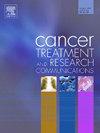未知分期癌症的特征、发病率和生存率:一项基于美国人群的研究
IF 2.4
Q3 Medicine
引用次数: 0
摘要
本研究基于报告来源、选定变量和癌症致死率,探讨了美国24个癌症部位的未知阶段癌症发病率的程度。方法分析了2015-2021年期间诊断的5,447,023例恶性癌症病例,这些病例来自监测、流行病学和最终结果(SEER)项目中22个基于人群的癌症登记处。泊松回归估计调整后的比率。结果大约9.4%的男性和7.2%的女性有未分期的癌症,不同的报告来源有显著差异。医院、医生或其他机构鉴定的未分期癌症水平;尸体解剖;死亡证明;男性分别为7.8%、32.6%、97.0%、82.0%,女性分别为5.8%、31.2%、97.1%、82.4%。当报告来源是医院、医生或其他来源时,比率随年龄增长而增加,但在尸检、死亡证明或护理/疗养院/临终关怀机构中,比率随年龄增长而下降。未分期的癌症发病率在男性和女性之间相似(r = 0.93, p <;0.0001,不包括乳腺癌)。然而,与女性相比,男性的未分期癌症发生率高出60% (95% CI 59% - 61%)。发病率随年龄的增长而增加,随收入的增加而下降,黑人(与白人相比)发病率高11% (95% CI 10% - 12%),西班牙裔(与非西班牙裔)发病率高11% (95% CI 10% - 12%)。未分期的癌症百分比与两性的5年相对生存率之间存在显著的负相关。结论男性、老年、黑人、西班牙裔和低收入患者更容易因合并症较高、癌症侵袭性更强、支付治疗费用较低而无法进入癌症阶段。本文章由计算机程序翻译,如有差异,请以英文原文为准。
Characteristics, incidence, and survival of unknown stage cancer: A US population-based study
Introduction
This study examines the extent of unknown stage cancer incidence for 24 cancer sites in the U.S. based on reporting source, selected variables, and cancer lethality.
Methods
Analyses included 5,447,023 malignant cancer cases diagnosed during 2015–2021, collected by 22 population-based cancer registries in the Surveillance, Epidemiology, and End Results (SEER) Program. Poisson regression estimated adjusted rate ratios.
Results
Approximately 9.4 % of males and 7.2 % of females had unstaged cancer, significantly varying by reporting source. Levels of unstaged cancer identified by hospital, physician, or other; autopsy; death certificate; or nursing/convalescent home/hospice were 7.8 %, 32.6 %, 97.0 %, and 82.0 % in males and 5.8 %, 31.2 %, 97.1 %, and 82.4 % in females, respectively. Rates increased with age when the reporting source was hospital, physician, or other but decreased with age for autopsy, death certificate, or nursing/convalescence home/hospice. Unstaged cancer rates were similar between men and women (r = 0.93, p < 0.0001, not including breast cancer). However, men were seen to have a 60 % higher rate of unstaged cancer (95 % CI 59 %-61 %) compared to women. Rates increased with age, decreased with income, and were 11 % (95 % CI 10 %-12 %) higher in Blacks (vs. Whites), and 11 % (95 % CI 10 %-12 %) higher in Hispanics (vs. non-Hispanics). A significant negative association was found between unstaged cancer percentages and 5-year relative survival rates for both sexes.
Conclusions
Males, older age, Blacks, Hispanics, and lower income patients are more susceptible to not receiving a cancer stage because of higher comorbid illness, more aggressive cancer, and less ability to pay for treatment.
求助全文
通过发布文献求助,成功后即可免费获取论文全文。
去求助
来源期刊

Cancer treatment and research communications
Medicine-Oncology
CiteScore
4.30
自引率
0.00%
发文量
148
审稿时长
56 days
期刊介绍:
Cancer Treatment and Research Communications is an international peer-reviewed publication dedicated to providing comprehensive basic, translational, and clinical oncology research. The journal is devoted to articles on detection, diagnosis, prevention, policy, and treatment of cancer and provides a global forum for the nurturing and development of future generations of oncology scientists. Cancer Treatment and Research Communications publishes comprehensive reviews and original studies describing various aspects of basic through clinical research of all tumor types. The journal also accepts clinical studies in oncology, with an emphasis on prospective early phase clinical trials. Specific areas of interest include basic, translational, and clinical research and mechanistic approaches; cancer biology; molecular carcinogenesis; genetics and genomics; stem cell and developmental biology; immunology; molecular and cellular oncology; systems biology; drug sensitivity and resistance; gene and antisense therapy; pathology, markers, and prognostic indicators; chemoprevention strategies; multimodality therapy; cancer policy; and integration of various approaches. Our mission is to be the premier source of relevant information through promoting excellence in research and facilitating the timely translation of that science to health care and clinical practice.
 求助内容:
求助内容: 应助结果提醒方式:
应助结果提醒方式:


